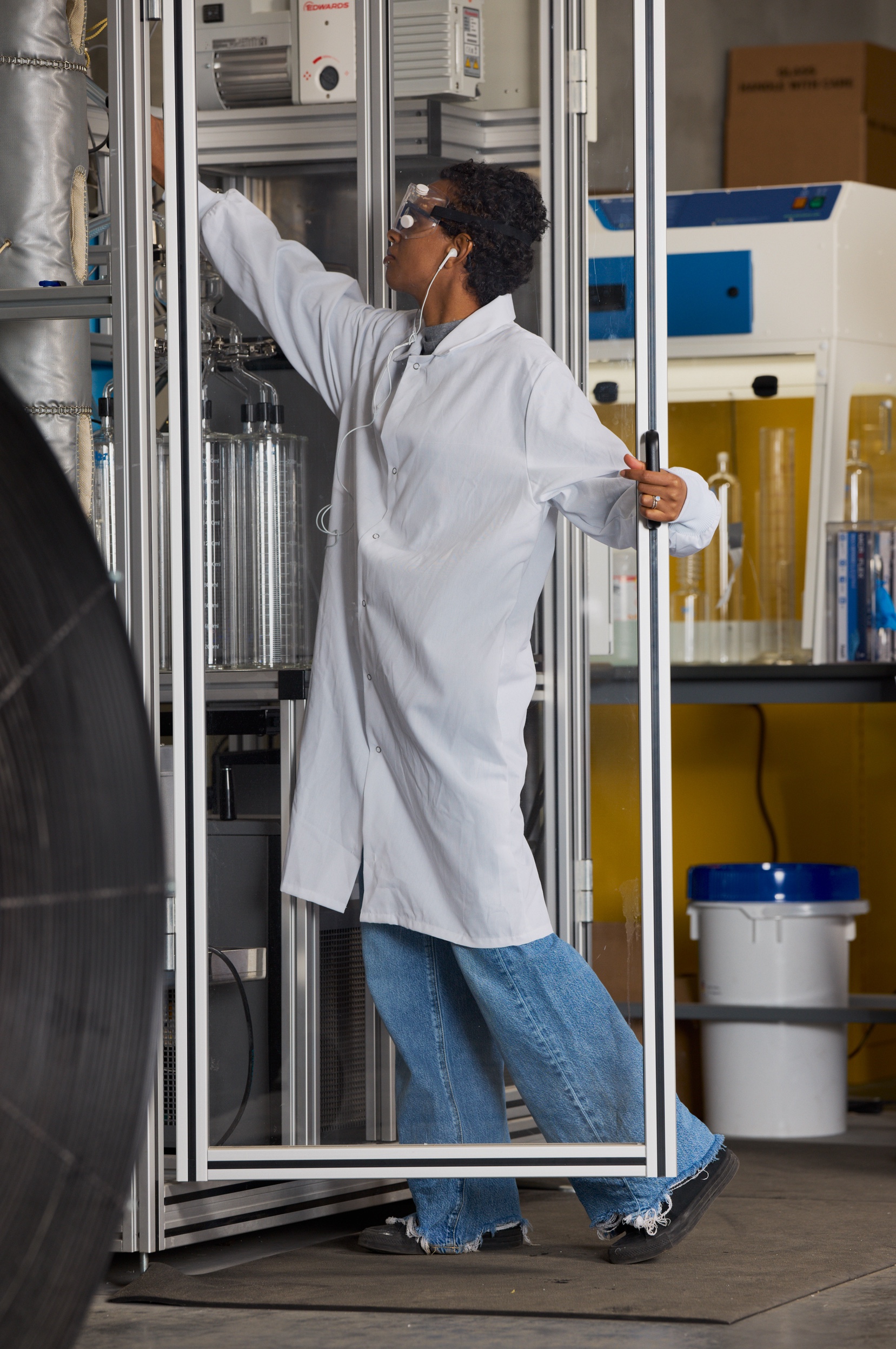
People urge us to “reduce, reuse, and recycle.” Choose an item you value — something which other people might consider garbage. How do you use it? Where did you find it?
Biosystems Engineer Mahlet Garedew, a green chemist, finds ways to turn coffee grounds and other waste into fuel.
According to the Environmental Protection Agency of the United States, “The transportation sector generates the largest share of greenhouse gas emissions.” In other words, a good deal of the carbon that Americans put into the atmosphere, heating planet Earth, comes from the gasoline, diesel, and jet fuel we burn to power our trucks, SUVS, minivans, cars, planes, and other forms of transportation. About sixteen percent of emissions come from transportation.
Planes alone burn a great deal of fuel. “The amount of jet fuel consumed in the world is massive (106 billion gallons)” and “the emissions from it are quite significant,” says Mahlet Garedew, a biosystems engineer and green chemist. She adds that about two percent of global carbon dioxide (CO2) emissions are produced by burning jet fuel.
One way to fix this problem, allowing us to travel for work as well as for fun without continuing to heat the planet up as quickly, may be to replace gas, diesel, and jet fuel with other kinds of more sustainable types of fuel. More and more cars are powered by batteries, making it possible to energize them with electricity produced by renewable sources (the sun and wind, for instance). And some cars, trucks, and planes use fuel made with ethanol, a type of alcohol made from beets, sugarcane, or corn and then mixed with gasoline to make “gasohol.” According to Garedew, sustainable aviation fuels (SAF) account for 0.1% of global jet fuel production.
Innovation Program Manager at AIR COMPANY, in Brooklyn, New York, Garedew has spent a good deal of her career helping research sustainable alternative fuels. What inspired her to choose this line of work?
Mahlet’s father, a chemical engineer working in Ethiopia, occasionally pulled her out of school to tour industrial plants or to join him at meetings of the Chemical Society of Ethiopia. People at these meetings often discussed industrial pollution and different ways it might be reduced.
Ethiopia’s high population and many cars contribute to its air pollution. Mahlet also noticed the waste collected in landfills. She wanted to help find solutions to these problems and paid particular attention to conversations about making ethanol from corn and from sugarcane to supplement fossil fuels with more renewable forms of energy. She didn’t know the term yet but “that was my very first experience with biofuels.”
Ethiopia did not have the infrastructure necessary to produce ethanol but the discussions Mahlet observed as a child taught her to be concerned about the problems created by the burning of coal and other fossil fuels and to consider alternatives.

In her own work, Garedew has focused on using waste products to produce liquid fuels. The advantage of liquid fuels is that they “can pack more energy per weight into hydrocarbons [an important part of fuel.]” And if they’re made from plant parts that would otherwise be thrown away, instead of plants grown on land that might otherwise provide people or other animals with food, or from CO2 captured from the atmosphere, all the better!
For tasks like getting a plane off the ground, you need a huge amount of energy. Imagine we began to produce energy-packed liquid fuels from waste produced on farms and in cities, taking plants whose growth involves absorbing carbon dioxide from the atmosphere and producing oxygen. Supposing we used the fruits and seeds from those plants for food and only their waste for fuel? Or what if we were to capture CO2 directly from the atmosphere and turn it into fuel? Might these methods help us reduce the amount of greenhouse gasses going into the atmosphere and slow the rate of global warming?
In her second year of graduate school at Michigan State University, Garedew helped investigate the process of turning coffee grounds into fuels and chemicals, using pyrolysis. Pyrolysis involves heating an organic material without oxygen and turning it into a liquid.
Referring to the lab where Garedew and her colleagues worked, she said that “the whole place smelled like barbecued coffee.” Bio-oil, she points out, can be used to make barbecue flavor after you purify it to make it ”food safe.” But to use it to fuel engines, you have to upgrade it, using electrocatalysis.
Two hydrogen atoms and an oxygen atom make up a water molecule (H2O). Using electricity, you can split water molecules into hydrogen and oxygen. The hydrogen can be used to upgrade the liquid from pyrolysis to help create fuels and chemicals from the coffee grounds.
Garedew and her team heated used coffee grounds to temperatures between 400 and 600 degrees Celsius. Water boils at 100 degrees Celsius … so think a bit about how very hot those coffee grounds became. Why didn’t they burn? Burning requires oxygen, which is kept out of the process of pyrolysis.
When your goal is to create fuels for transportation, you want to produce as much usable liquid (bio-oil) as possible. As Garedew and her colleagues wrote in the summary of their work, “Highest bio-oil yield (61.8%) was observed at 500 [degrees] C while the highest char yield (20.6% w/w) was produced at the lowest temperature of 429 [degrees] C…. Because of the abundance of spent coffee grounds and the quality of its bio-oil, this waste stream offers potential as a valuable bioenergy feedstock.”
Using waste products to make fuel from recently grown plants, rather than pulling fossil fuels like oil and natural gas up from deep underground lowers the carbon produced and released by the process of making and using that fuel. If you use renewable energy sources for the power required to turn the waste products into fuel, you can improve the benefits to the environment even more. AIR COMPANY uses electricity produced from solar and wind power to split water molecules to produce the hydrogen needed for CO2 conversion.
They turn waste products into long-chain hydrocarbons like paraffins, which can be used in jet fuel. “If you can recycle even part of the CO2 emitted, you’re making a very significant impact.” But to make that impact, sustainable aviation fuels (SAF) production needs to happen at a very large scale.
The lignin that makes up a lot of biomass waste products is a polymer and one of the main contents of wood. It’s available in enormous amounts on our planet. Lignin adds strength and waterproofing to plants’ cell walls — Garedew calls lignin “the structural component of the plant — the bark and other structural parts.” When fungi invade a plant, “lignin protects the plant from decay.”

Garedew’s doctoral research involved using pyrolysis to create fuels for transportation out of lignin. “A lot of the stuff I did was chemistry,” so an organic chemistry professor was one of her advisors. The other was a bio systems engineering professor. “Engineers think more about scaling,” Garedew told Math4Science — they want to make sure the processes they use can be repeated widely, working for many people on a large scale. Organic chemists focus more on the molecules at work in a given process. Garedew appreciated working with both advisors and “learned a lot from them about how to think in different ways and how to look at problems through different lenses.”
In her postdoc at the Center for Green Chemistry and Green Engineering, at Yale University, she worked with other green chemists. At Yale, she learned more about how to incorporate the Principles of Green Chemistry into her work.
At AIR COMPANY, Garedew enjoys working with people whose educations and areas of specialization mean they can contribute different approaches to the work the organization does. She works with engineers, physicists, chemists, and other specialists, each one providing a different perspective and doing their part to convert carbon dioxide into fuels, using water, electricity, and catalysts to help them do that.
”Sustainable fuels have come a long way,” says Garedew. “They might not be the only answer” to global warming and the need for renewable sources of energy. But they are “a big part of the equation.” And “of course we use math for every single thing,” from keeping track of the energy and ingredients the systems they use require, to measuring the impacts of those systems on the environment. AIR COMPANY looks at “how the carbon dioxide got there” and “how much energy and carbon go into each step.” That helps them improve the energy efficiency of their work.
At a small scale, they may release heat that they can’t afford to recapture. But “at larger scales you can include some infrastructure to harness that heat and use it for heating purposes in your own system or elsewhere.”
“Nature,” says Garedew, “continues to inspire human innovation.” When she’s having a tough day, she thinks about her interpretation of the essence of green chemistry, “this idea that we are part of nature — we are part of this whole system.” “If we see it as an extension of ourselves, we can move and work in ways that are better for the environment and [our] fellow beings.”


